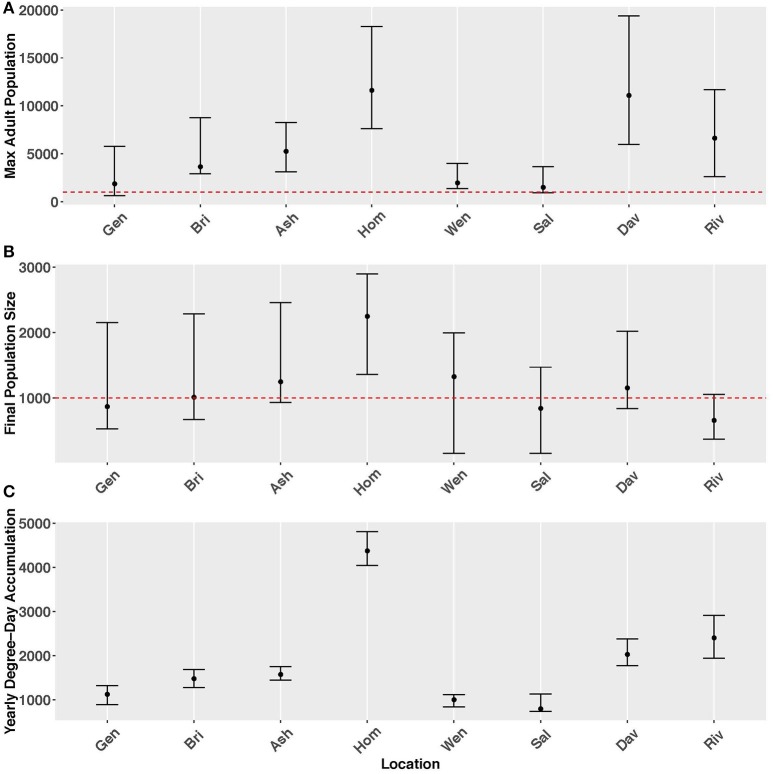In this manuscript, we present model results from eight locations over 10 years based on temperatures at weather stations and photoperiod. We inadvertently made a poor choice for a weather station to represent Wenatchee WA. To avoid heat island effects, we chose the Grouse Camp weather station to represent Wenatchee. However, although Grouse Camp is only 21 km from Wenatchee, it is in a mountainous area (1,642 m elevation) and poorly represents the climate in the apple growing region of Wenatchee, WA (190 m elevation). Thus, the results do not reflect potential population dynamics of H. halys in Wenatchee. In re-evaluation of the model, the data show that populations at Wenatchee, WA, are predicted to behave similarly to those at Salem, OR, with an average albeit marginal positive population growth. Conclusions that were driven heavily by photoperiod, such as the range in days for initiation of oviposition by overwintered adults, were less affected (from 16 down to 13 days). The strong differences were due to markedly higher degree day accumulations at Wenatchee versus Grouse Camp.
The following six files use the same order of tables and figures from the original manuscript and use the Weather Station data for Wenatchee, WA (network ID: GHCND:USC00459074).
Table 2. Model outputs defining key population parameters for the years 2005–2014.
Figure 7. Model predictions of adult population size for Wenatchee, WA. P represented parental overwintered adults, which was initialized as 1000 for each year and for each simulation run.
Figure 8. Predicted population sizes (+/− range from all simulations and years) across all geographic locations for (A) maximum adult population size, and (B) final population size, and (C) yearly degree-day accumulation. The error bars represent the standard errors from 100 simulations for the metrics.
Figure S3. Predicted total population size by life stage for Wenatchee, WA from 2005 through 2014. Populations were initialized with 1000 adults for each year and simulation run.
Figure S5. Degree-day accumulation for Halyomorpha halys development in Wenatchee, WA from 2005 through 2014.
Figure S7. Predicted total population size by generation for Wenatchee, WA.
Table 2.
Model outputs defining key population parameters for the years 2005-2014.
| Location | Coordinates | Crop | Non-diapause range | P Oviposition | F1 Eclosion | F2 Eclosion | Final adult population | ||||
|---|---|---|---|---|---|---|---|---|---|---|---|
| Range | Median | Range | Median | Range | Median | F1 | F2 | ||||
| Geneva NY | 42.88°N 76.99°W | Apple | Apr 18–Aug 26 | May 30–Jun 17 | Jun 7 | Jun 21–Jul 18 | Jun 30 | Jul 19–Aug 9 | Jul 28 | 243–447 | 81–1,847 |
| Bridgeton NJ | 39.43°N 75.23°W | Peach/Vegetable | Apr 22–Aug 22 | Jun 3–Jun 6 | Jun 4 | Jun 9–Jul 2 | Jun 23 | Jul 6–Jul 31 | Jul 24 | 140–278 | 531–2,027 |
| Asheville NC | 35.58°N 85.56°W | Tree fruit/Vegetable | Apr 28–Aug 17 | May 28–May 29 | May 29 | Jun 3–Jun 11 | Jun 6 | Jun 25–Jul 4 | Jul 2 | 89–253 | 803–2,287 |
| Homestead FL | 25.47°N 80.47°W | Tomato/Strawberry | May 24–July 22 | Jun 5–Jun 6 | Jun 6 | Jun 17–Jun 18 | Jun 18 | Jul 8–Jul 10 | Jul 9 | 44–137 | 1318–2,781 |
| Wenatchee WA | 47.42°N 120.33°W | Apple/Pear | Apr 14–Aug 31 | Jun 2–Jun 15 | Jun 8 | Jun 17–Jun 29 | Jun 22 | Aug 1–Aug 18 | Aug 6 | 106–559 | 46–1,557 |
| Salem OR | 44.93°N 123.03°W | Tree fruit/Wine grape | Apr 17–Aug 28 | Jun 8–Jun 9 | Jun 9 | Jun 17–Jul 2 | Jun 26 | Jul 24–Jul 31 | Jul 27 | 269–716 | 33–1,035 |
| Davis CA | 38.55°N 121.74°W | Tomato | Apr 24–Aug 20 | Jun 3–Jun 4 | Jun 4 | Jun 14–Jun 19 | Jun 16 | Jul 6–Jul 15 | Jul 11 | 75–255 | 733–1,893 |
| Riverside CA | 33.95°N 117.40°W | Citrus | May 1–Aug 13 | Jun 10–Jun 11 | Jun 11 | Jun 20–Jun 24 | Jun 23 | Jul 8–Jul 16 | Jul 13 | 21–95 | 349–962 |
Figure 7.
Model predictions of adult population size for Wenatchee, WA. P represented parental overwintered adults, which was initialized as 1,000 for each year and for each simulation run.
Figure 8.
Predicted population sizes (+/− range from all simulations and years) across all geographic locations for (A) maximum adult population size, and (B) final population size, and (C) yearly degree-day accumulation. The error bars represent the standard errors from 100 simulations for the metrics.
We thank V. Jones for bringing this error to our attention, and the Frontiers journal for allowing us to add this Corrigendum.
Conflict of interest statement
The authors declare that the research was conducted in the absence of any commercial or financial relationships that could be construed as a potential conflict of interest.
Acknowledgments
This material is based upon the work supported by the National Institute of Food and Agriculture, U.S. Department of Agriculture, under award number SCRI 2011-51181-30937.
References
- Weather Station: Wenatchee, WA: (Network ID: GHCND:USC00459074). [Google Scholar]




